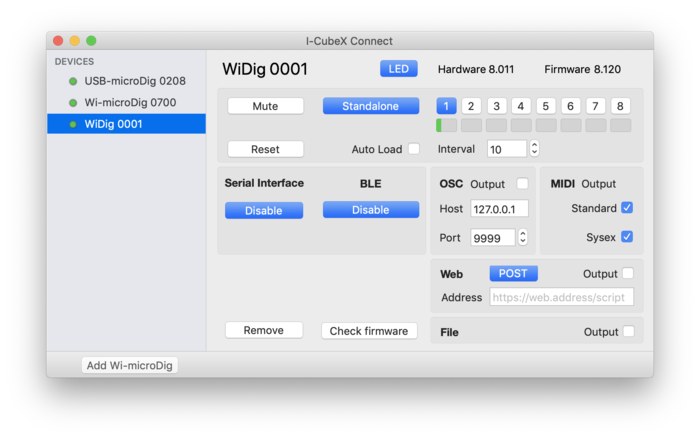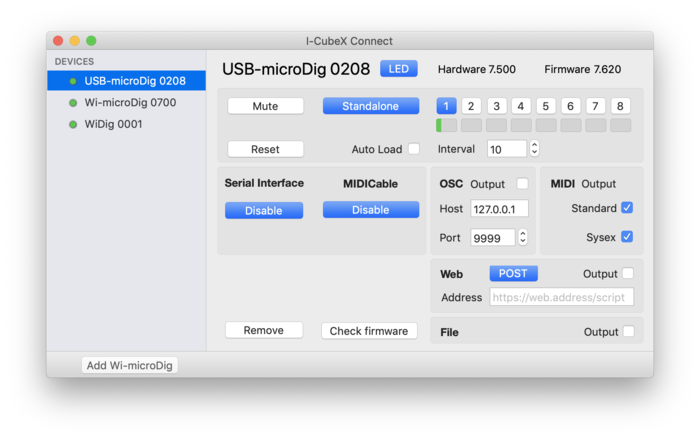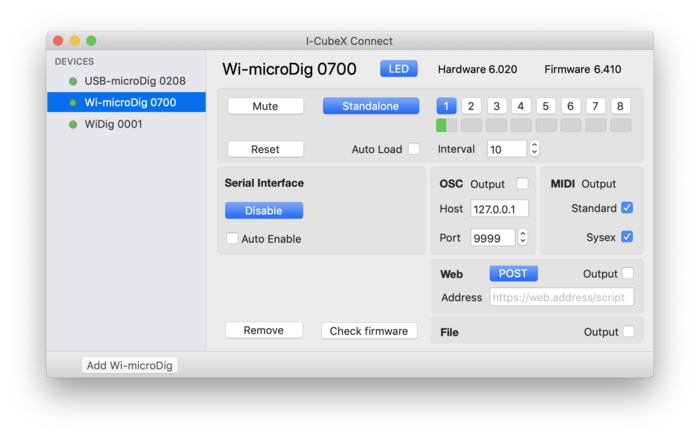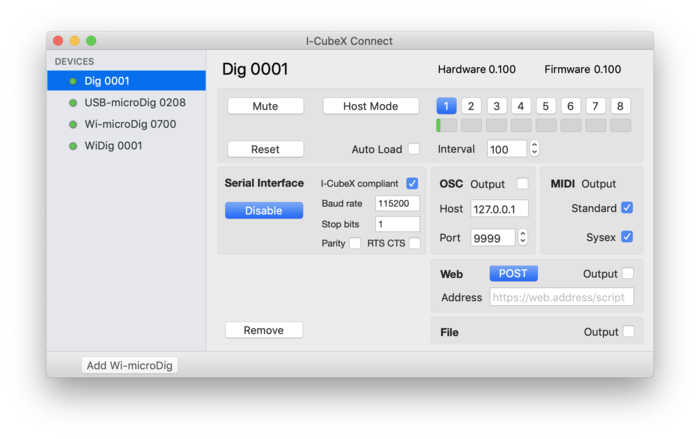Connect-170 Digitizer View
The digitizer view window is opened by selecting "Devices" from the main menu in the MacOS task bar. It will show the last viewed device. A specific device can be viewed by selecting its menu entry from the main menu. The digitizer view allows you to configure the digitizer's serial interface, its mapping to MIDI, OSC and Web messages, enable logging to file, and it allows you to partially configure the digitizer itself using a mini editor.
Contents
Serial interface
The serial interface can be enabled or disabled. When the status is disabled the digitizer's serial port is available for other software to connect to and all the configuration options in the Digitizer view are hidden. The auto-enable feature for Wi-microDigs, if checked, sets Connect to attempt on startup to enable the Bluetooth Classic link and serial interface of the Wi-microDig, and when the Wi-microDig's Bluetooth link is temporarily lost, eg. due to power interruption, to attempt to re-establish the Bluetooth link. If the attempt fails a dialog will appear giving you the option to cancel further attempts. Unplugging a WiDig, USB-microDig or powering off a Wi-microDig will disable its serial interface. Unless the preferences have been set to dispose of MIDI ports upon disabling the serial interface of a device, the device's MIDI port will remain present in the operating system after disabling its serial port as long as Connect is running.
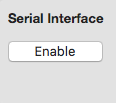
|
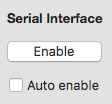
|
LEDs
The LED button (available for firmwares dated 27 July 2020 or newer) enables turning on/off Bluetooth/WiFi, MIDI in/out and power LEDs to save power and for a less visible presence of the WiDig on stage or in an installation.
Wireless
Depending on the digitizer hardware, a section will be available to enable or disable the WiFi, BLE or MIDICable interface. Switching between wireless (WiFi or BLE) and wired modes takes a few seconds as the WiDig has to reboot. If a WiDig with WiFi capability is connected and an IP address is shown once it is connected to a WiFi network, click the address to go to the WiDig's web configuration page. When using WiFi, clicking the Enable/Disable button turns on/off WiFi. Holding down the Alt/Option key while clicking the Disable button deletes the WiFi access credentials if they were previously entered (see WiConnect QuickStart for details). The MIDICable feature allows a USB-microDig to be connected directly via a physical MIDI cable to a MIDI device. To use it, after enabling it, a USB-microMIDICable has to be connected to the USB-microDig.
Mapping
The MIDI and OSC mapping and Webhook URL GET/POST features can be turned on or off by clicking the feature's checkbox. See the applicable sections in this wiki for details.
Mini editor
The mini editor provides limited control over the internal configuration of the digitizer. See the Mini Editor section for details. To access all the digitizer's standalone mode configuration settings use EditorX.
Remove
Clicking the "Remove" button disables the digitizer's serial interface (making it available to other software), disposes of the MIDI port associated with the digitizer and then removes the digitizer from the device list.
Firmware
The "Check Firmware" button allows you to manually check for the latest firmware version for the connected digitizer. If a newer version is available it can be uploaded to the digitizer, see the Firmware Upload section.
Click the firmware version number to switch it to show the firmware date. Click again to show the version number again. If a WiDig is displayed, click the label "Firmware" to switch to displaying the WiConnect version number (and date, if clicked on the number).
Quit
Quit Connect by selecting "Quit" from the menu in the taskbar or by pressing the Command key together with "Q" on the keyboard.
WiDig BLE
WiDig WiFi
USB-microDig
Wi-microDig
Other serial devices
The "Add Other" option in the main menu, if used to select the serial port of an "iCubino", ie. an Arduino that is made I-CubeX compatible by uploading the iCubino sketch to it, adds the iCubino to the device list, and makes it available to I-CubeX software such as Link. It can also be mapped to MIDI and/or OSC and/or a Webhook URL address for use in IoT (Internet of Things) applications. Serial devices that are not I-CubeX compatible can also be added to the device list, and data received from them will then be output as MIDI. OSC output and sending Webhook URL GET/POST requests is only applicable to I-CubeX compatible serial devices.
